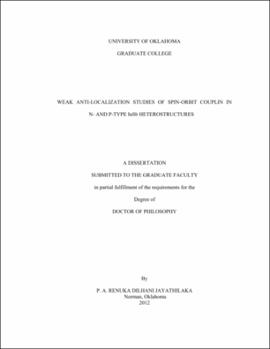| dc.contributor.advisor | . Murphy, Sheena Q | |
| dc.creator | Jayathilaka, Renuka Dilhani | |
| dc.date.accessioned | 2019-04-27T21:23:44Z | |
| dc.date.available | 2019-04-27T21:23:44Z | |
| dc.date.issued | 2012 | |
| dc.identifier | 99146305602042 | |
| dc.identifier.uri | https://hdl.handle.net/11244/318571 | |
| dc.description.abstract | The effects of spin-orbit interactions (SOIs) on transport properties of InSb/AlInSb heterostructures have been studied experimentally. At low temperatures, the quantum interference gives rise to a quantum correction to the classical Drude conductance. For 2D systems, the dominant quantum corrections are due to weak anti-localization (WAL) and electron-electron interaction effects. This thesis is concerned with these contributions. | |
| dc.description.abstract | The first part of this dissertation describes the development of device fabrication processes for InSb material, including electron beam lithography (EBL) and dry etching (RIE). The second part describes two separate magneto-transport measurements performed in 2D electron and hole systems as well as in 1D wire arrays fabricated from 2D electron gases. Both experiments employ low field magneto-transport measurements to explore the SOI. | |
| dc.description.abstract | Spin-orbit effects in III-V semiconductor heterostructures arise from two distinct inversion asymmetries: bulk inversion asymmetry (Dresselhaus) and structural inversion asymmetry (Rasha), due to crystalline anisotropy in III-V zincblende crystal and heterointerface, respectively. In the first set of experiments, we studied symmetrically doped InSb/AlInSb heterostructures with comparable magnitude spin orbit contributions from both linear and cubic Dresselhaus. In this limit the spin-split Fermi surface are four-fold symmetric and present minimal and maximal spin-orbit (SO) fields along the [100] and [110] direction, respectively. For this experiment, Hall bars (HB) and arrays of quasi-1D wires were patterned along these crystallographic directions for a (100) growth plane to reveal the anisotropic spin-split Fermi surface. The arrays of 1D wires were fabricated using EBL and reactive ion etching. Using weak localization (WL) analysis, we calculated a Dresselhaus constant &gama; = 520±20 eVÅ 3; for our particular InSb QW, in very good agreement with the theoretically predicted value. Suppression of spin relaxation was observed as the channel was narrowed and wires aligned along the [100] direction displayed spin relaxation lengths ~30% longer than for wires aligned along [110] due to the additional influence of the cubic Dresselhaus which is predicted to be unaffected by dimensional confinement. Additionally in the diffusive regime, electron-electron scattering responsible for dephasing was investigated as a function of temperature. | |
| dc.description.abstract | The second set of experiments focused on the geometry dependence of Rashba spin splitting of the valence band (VB) in the 2D hole system. In a 2D hole system, the Rashba coupling can be modified by varying the carrier concentration and by changing the confinement. Compared to the 2DE system, we observed a huge spin splitting, ~2-5meV. While the observed spins splitting were in qualitative agreement with theoretical expectation, there was substantial quantitative disagreement. | |
| dc.format.extent | 125 pages | |
| dc.format.medium | application.pdf | |
| dc.language | en_US | |
| dc.relation.requires | Adobe Acrobat Reader | |
| dc.subject | Nuclear spin | |
| dc.subject | Molecular orbitals | |
| dc.subject | Indium antimonide crystals | |
| dc.title | WEAK ANTI-LOCALIZATION STUDIES OF SPIN-ORBIT COUPLING IN N- AND P-TYPE InSb HETEROSTRUCTURES | |
| dc.type | text | |
| dc.type | document | |
| dc.thesis.degree | Ph.D. | |
| ou.group | College of Arts and Sciences::Homer L. Dodge Department of Physics and Astronomy | |
